Analysis of Facilitating Changes in Health and Social Care at LBH
VerifiedAdded on 2019/12/17
|17
|5731
|235
Report
AI Summary
This report examines the facilitation of changes within the health and social care sector, using London Bridge Hospital as a focal point. The report begins with an introduction to the health and social care sector, highlighting its importance and the various changes it undergoes, including technological, legal, and political modifications. The report then proceeds to analyze the external and internal factors that influence London Bridge Hospital's operations, employing PEST, SWOT, and 5M analyses to assess the hospital's market position, strengths, weaknesses, opportunities, and threats. The report also explores the challenges associated with change management, such as resistance to change and the incorporation of new practices. The report provides insights into how these changes are planned and implemented, and how London Bridge Hospital adapts to maintain its competitive edge. Finally, the report emphasizes the significance of adapting to these changes to ensure long-term survival and the provision of high-quality healthcare services.

FACILITATING
CHANGES IN
HEALTH AND SOCIAL CARE
1
CHANGES IN
HEALTH AND SOCIAL CARE
1
Secure Best Marks with AI Grader
Need help grading? Try our AI Grader for instant feedback on your assignments.

Table of Contents
INTRODUCTION ...............................................................................................................................3
TASK 1.................................................................................................................................................3
1.1, 1.2.............................................................................................................................................3
TASK 2.................................................................................................................................................6
1.......................................................................................................................................................6
TASK 3.................................................................................................................................................9
References..........................................................................................................................................12
2
INTRODUCTION ...............................................................................................................................3
TASK 1.................................................................................................................................................3
1.1, 1.2.............................................................................................................................................3
TASK 2.................................................................................................................................................6
1.......................................................................................................................................................6
TASK 3.................................................................................................................................................9
References..........................................................................................................................................12
2

INTRODUCTION
Health and social care is a term that refers to service that is accessible from health and social
care providers. It is a broad aspect that relates to the entire range of health care facilities,
infrastructure, etc. The primary objective of this sector is to assure the sound health of all the living
beings, reduce mortality rate, increase life expectancy rate and assure accessibility of health care
services to all. The health and social care sector is subject to wide range of modifications like,
technological, legal, political, etc (Ivey, Ivey and Zalaquett, 2013 ). These changes have a direct
impact on the operations of the entity. In order to survive in the long run, it is important for health
care entity to cope with the changes in its external and internal environment. The major changes in
HSC are due to rapid advancement in technology which further helps in providing better quality
services to the patients. In this report, learning will be shown regarding facilitating changes in
leading health and social care entity like London Bridge hospital.
It is leading private hospital in London that provide a wide range of healthcare services to its
patients. The hospital is known for rendering modern and advanced health care services. The
mission of the hospital is to render its services with full compassion, kindness, honesty integrity and
fairness. However, recently rapid changes in health care sector are impacting the working of
London Bridge Hospital and stimulate entity to incorporate such modification in business. Such as,
light bulbs has been developed to disinfect and kill bacteria. After that, the functioning of the The
resistance is also affected by the origin of health informatics. The company is forced to invest in
research and development department so that it can identify and incorporate new techniques
through which better quality services an be rendered to the patient. Other than this, fluctuations in
an economic and political situation of the country also have a direct impact on the working of
London Bridge hospital. In this report, learning will be shown regarding the key factors that drive
changes in HSC. The impact of these changes on the mode of service delivery in London Bridge
Hospital will be explained. The learning will be shown regarding the main principles of change
management. In addition to t hi s aspect, explanation will be provided regarding how changes in
HSC are planned
TASK 1
1.1, 1.2
There are different kinds of external and internal factors that drive changes that impact the working
of London Bridge hospital. The external factors are those that are outside the working of the entity
and are bound the control of the company. It further refers to factors like political, technological,
3
Health and social care is a term that refers to service that is accessible from health and social
care providers. It is a broad aspect that relates to the entire range of health care facilities,
infrastructure, etc. The primary objective of this sector is to assure the sound health of all the living
beings, reduce mortality rate, increase life expectancy rate and assure accessibility of health care
services to all. The health and social care sector is subject to wide range of modifications like,
technological, legal, political, etc (Ivey, Ivey and Zalaquett, 2013 ). These changes have a direct
impact on the operations of the entity. In order to survive in the long run, it is important for health
care entity to cope with the changes in its external and internal environment. The major changes in
HSC are due to rapid advancement in technology which further helps in providing better quality
services to the patients. In this report, learning will be shown regarding facilitating changes in
leading health and social care entity like London Bridge hospital.
It is leading private hospital in London that provide a wide range of healthcare services to its
patients. The hospital is known for rendering modern and advanced health care services. The
mission of the hospital is to render its services with full compassion, kindness, honesty integrity and
fairness. However, recently rapid changes in health care sector are impacting the working of
London Bridge Hospital and stimulate entity to incorporate such modification in business. Such as,
light bulbs has been developed to disinfect and kill bacteria. After that, the functioning of the The
resistance is also affected by the origin of health informatics. The company is forced to invest in
research and development department so that it can identify and incorporate new techniques
through which better quality services an be rendered to the patient. Other than this, fluctuations in
an economic and political situation of the country also have a direct impact on the working of
London Bridge hospital. In this report, learning will be shown regarding the key factors that drive
changes in HSC. The impact of these changes on the mode of service delivery in London Bridge
Hospital will be explained. The learning will be shown regarding the main principles of change
management. In addition to t hi s aspect, explanation will be provided regarding how changes in
HSC are planned
TASK 1
1.1, 1.2
There are different kinds of external and internal factors that drive changes that impact the working
of London Bridge hospital. The external factors are those that are outside the working of the entity
and are bound the control of the company. It further refers to factors like political, technological,
3
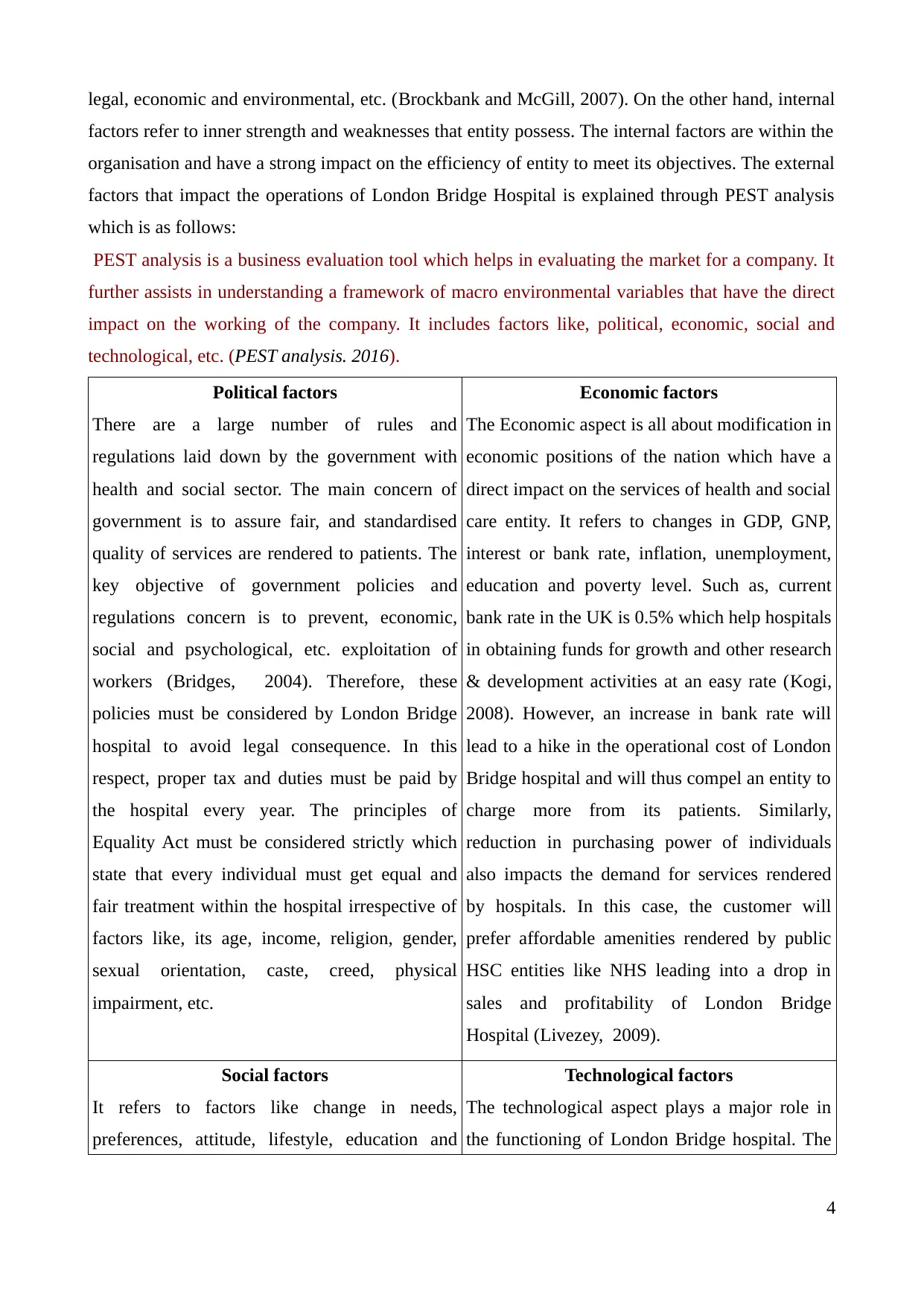
legal, economic and environmental, etc. (Brockbank and McGill, 2007). On the other hand, internal
factors refer to inner strength and weaknesses that entity possess. The internal factors are within the
organisation and have a strong impact on the efficiency of entity to meet its objectives. The external
factors that impact the operations of London Bridge Hospital is explained through PEST analysis
which is as follows:
PEST analysis is a business evaluation tool which helps in evaluating the market for a company. It
further assists in understanding a framework of macro environmental variables that have the direct
impact on the working of the company. It includes factors like, political, economic, social and
technological, etc. (PEST analysis. 2016).
Political factors
There are a large number of rules and
regulations laid down by the government with
health and social sector. The main concern of
government is to assure fair, and standardised
quality of services are rendered to patients. The
key objective of government policies and
regulations concern is to prevent, economic,
social and psychological, etc. exploitation of
workers (Bridges, 2004). Therefore, these
policies must be considered by London Bridge
hospital to avoid legal consequence. In this
respect, proper tax and duties must be paid by
the hospital every year. The principles of
Equality Act must be considered strictly which
state that every individual must get equal and
fair treatment within the hospital irrespective of
factors like, its age, income, religion, gender,
sexual orientation, caste, creed, physical
impairment, etc.
Economic factors
The Economic aspect is all about modification in
economic positions of the nation which have a
direct impact on the services of health and social
care entity. It refers to changes in GDP, GNP,
interest or bank rate, inflation, unemployment,
education and poverty level. Such as, current
bank rate in the UK is 0.5% which help hospitals
in obtaining funds for growth and other research
& development activities at an easy rate (Kogi,
2008). However, an increase in bank rate will
lead to a hike in the operational cost of London
Bridge hospital and will thus compel an entity to
charge more from its patients. Similarly,
reduction in purchasing power of individuals
also impacts the demand for services rendered
by hospitals. In this case, the customer will
prefer affordable amenities rendered by public
HSC entities like NHS leading into a drop in
sales and profitability of London Bridge
Hospital (Livezey, 2009).
Social factors
It refers to factors like change in needs,
preferences, attitude, lifestyle, education and
Technological factors
The technological aspect plays a major role in
the functioning of London Bridge hospital. The
4
factors refer to inner strength and weaknesses that entity possess. The internal factors are within the
organisation and have a strong impact on the efficiency of entity to meet its objectives. The external
factors that impact the operations of London Bridge Hospital is explained through PEST analysis
which is as follows:
PEST analysis is a business evaluation tool which helps in evaluating the market for a company. It
further assists in understanding a framework of macro environmental variables that have the direct
impact on the working of the company. It includes factors like, political, economic, social and
technological, etc. (PEST analysis. 2016).
Political factors
There are a large number of rules and
regulations laid down by the government with
health and social sector. The main concern of
government is to assure fair, and standardised
quality of services are rendered to patients. The
key objective of government policies and
regulations concern is to prevent, economic,
social and psychological, etc. exploitation of
workers (Bridges, 2004). Therefore, these
policies must be considered by London Bridge
hospital to avoid legal consequence. In this
respect, proper tax and duties must be paid by
the hospital every year. The principles of
Equality Act must be considered strictly which
state that every individual must get equal and
fair treatment within the hospital irrespective of
factors like, its age, income, religion, gender,
sexual orientation, caste, creed, physical
impairment, etc.
Economic factors
The Economic aspect is all about modification in
economic positions of the nation which have a
direct impact on the services of health and social
care entity. It refers to changes in GDP, GNP,
interest or bank rate, inflation, unemployment,
education and poverty level. Such as, current
bank rate in the UK is 0.5% which help hospitals
in obtaining funds for growth and other research
& development activities at an easy rate (Kogi,
2008). However, an increase in bank rate will
lead to a hike in the operational cost of London
Bridge hospital and will thus compel an entity to
charge more from its patients. Similarly,
reduction in purchasing power of individuals
also impacts the demand for services rendered
by hospitals. In this case, the customer will
prefer affordable amenities rendered by public
HSC entities like NHS leading into a drop in
sales and profitability of London Bridge
Hospital (Livezey, 2009).
Social factors
It refers to factors like change in needs,
preferences, attitude, lifestyle, education and
Technological factors
The technological aspect plays a major role in
the functioning of London Bridge hospital. The
4
Secure Best Marks with AI Grader
Need help grading? Try our AI Grader for instant feedback on your assignments.
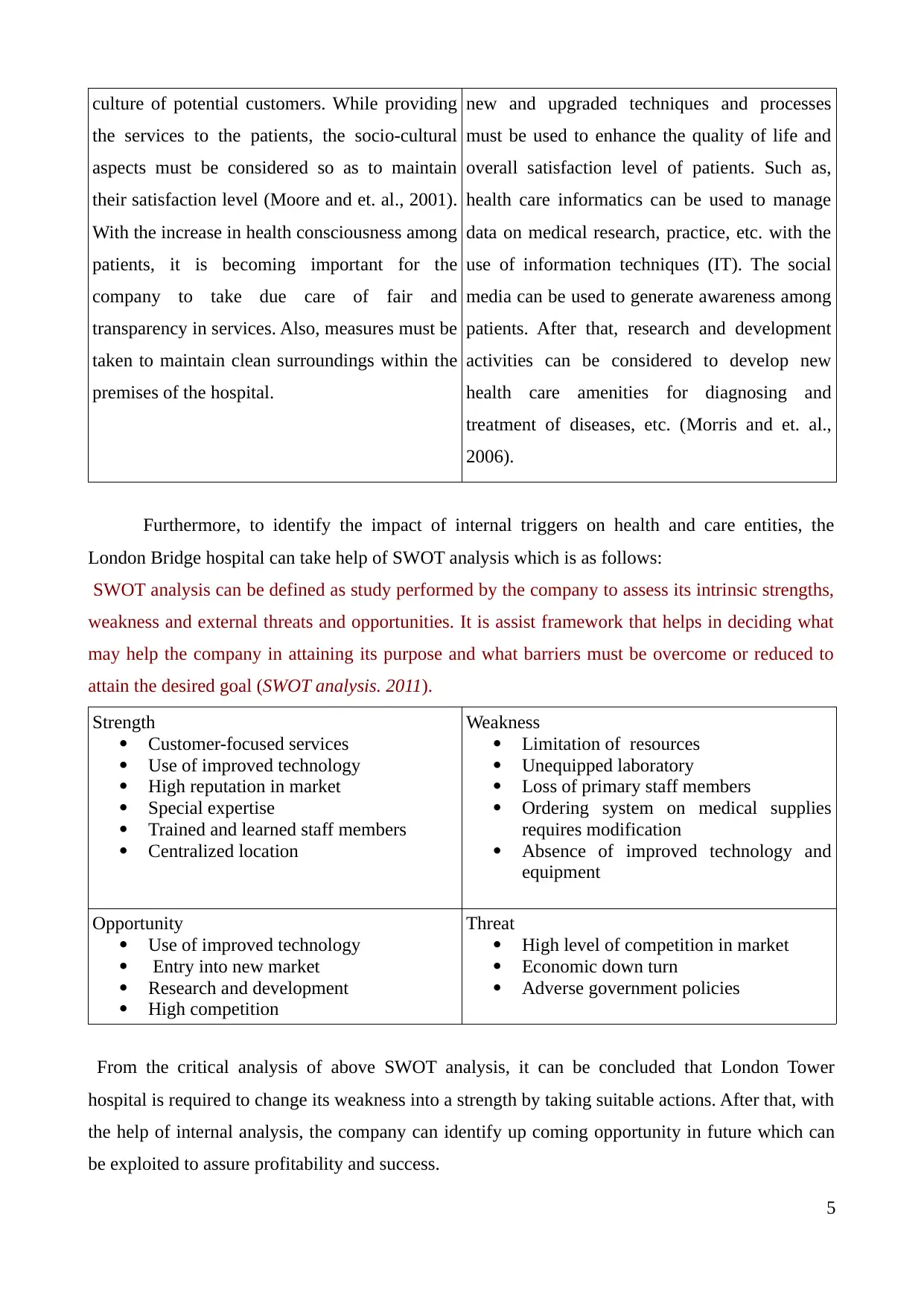
culture of potential customers. While providing
the services to the patients, the socio-cultural
aspects must be considered so as to maintain
their satisfaction level (Moore and et. al., 2001).
With the increase in health consciousness among
patients, it is becoming important for the
company to take due care of fair and
transparency in services. Also, measures must be
taken to maintain clean surroundings within the
premises of the hospital.
new and upgraded techniques and processes
must be used to enhance the quality of life and
overall satisfaction level of patients. Such as,
health care informatics can be used to manage
data on medical research, practice, etc. with the
use of information techniques (IT). The social
media can be used to generate awareness among
patients. After that, research and development
activities can be considered to develop new
health care amenities for diagnosing and
treatment of diseases, etc. (Morris and et. al.,
2006).
Furthermore, to identify the impact of internal triggers on health and care entities, the
London Bridge hospital can take help of SWOT analysis which is as follows:
SWOT analysis can be defined as study performed by the company to assess its intrinsic strengths,
weakness and external threats and opportunities. It is assist framework that helps in deciding what
may help the company in attaining its purpose and what barriers must be overcome or reduced to
attain the desired goal (SWOT analysis. 2011).
Strength
Customer-focused services
Use of improved technology
High reputation in market
Special expertise
Trained and learned staff members
Centralized location
Weakness
Limitation of resources
Unequipped laboratory
Loss of primary staff members
Ordering system on medical supplies
requires modification
Absence of improved technology and
equipment
Opportunity
Use of improved technology
Entry into new market
Research and development
High competition
Threat
High level of competition in market
Economic down turn
Adverse government policies
From the critical analysis of above SWOT analysis, it can be concluded that London Tower
hospital is required to change its weakness into a strength by taking suitable actions. After that, with
the help of internal analysis, the company can identify up coming opportunity in future which can
be exploited to assure profitability and success.
5
the services to the patients, the socio-cultural
aspects must be considered so as to maintain
their satisfaction level (Moore and et. al., 2001).
With the increase in health consciousness among
patients, it is becoming important for the
company to take due care of fair and
transparency in services. Also, measures must be
taken to maintain clean surroundings within the
premises of the hospital.
new and upgraded techniques and processes
must be used to enhance the quality of life and
overall satisfaction level of patients. Such as,
health care informatics can be used to manage
data on medical research, practice, etc. with the
use of information techniques (IT). The social
media can be used to generate awareness among
patients. After that, research and development
activities can be considered to develop new
health care amenities for diagnosing and
treatment of diseases, etc. (Morris and et. al.,
2006).
Furthermore, to identify the impact of internal triggers on health and care entities, the
London Bridge hospital can take help of SWOT analysis which is as follows:
SWOT analysis can be defined as study performed by the company to assess its intrinsic strengths,
weakness and external threats and opportunities. It is assist framework that helps in deciding what
may help the company in attaining its purpose and what barriers must be overcome or reduced to
attain the desired goal (SWOT analysis. 2011).
Strength
Customer-focused services
Use of improved technology
High reputation in market
Special expertise
Trained and learned staff members
Centralized location
Weakness
Limitation of resources
Unequipped laboratory
Loss of primary staff members
Ordering system on medical supplies
requires modification
Absence of improved technology and
equipment
Opportunity
Use of improved technology
Entry into new market
Research and development
High competition
Threat
High level of competition in market
Economic down turn
Adverse government policies
From the critical analysis of above SWOT analysis, it can be concluded that London Tower
hospital is required to change its weakness into a strength by taking suitable actions. After that, with
the help of internal analysis, the company can identify up coming opportunity in future which can
be exploited to assure profitability and success.
5
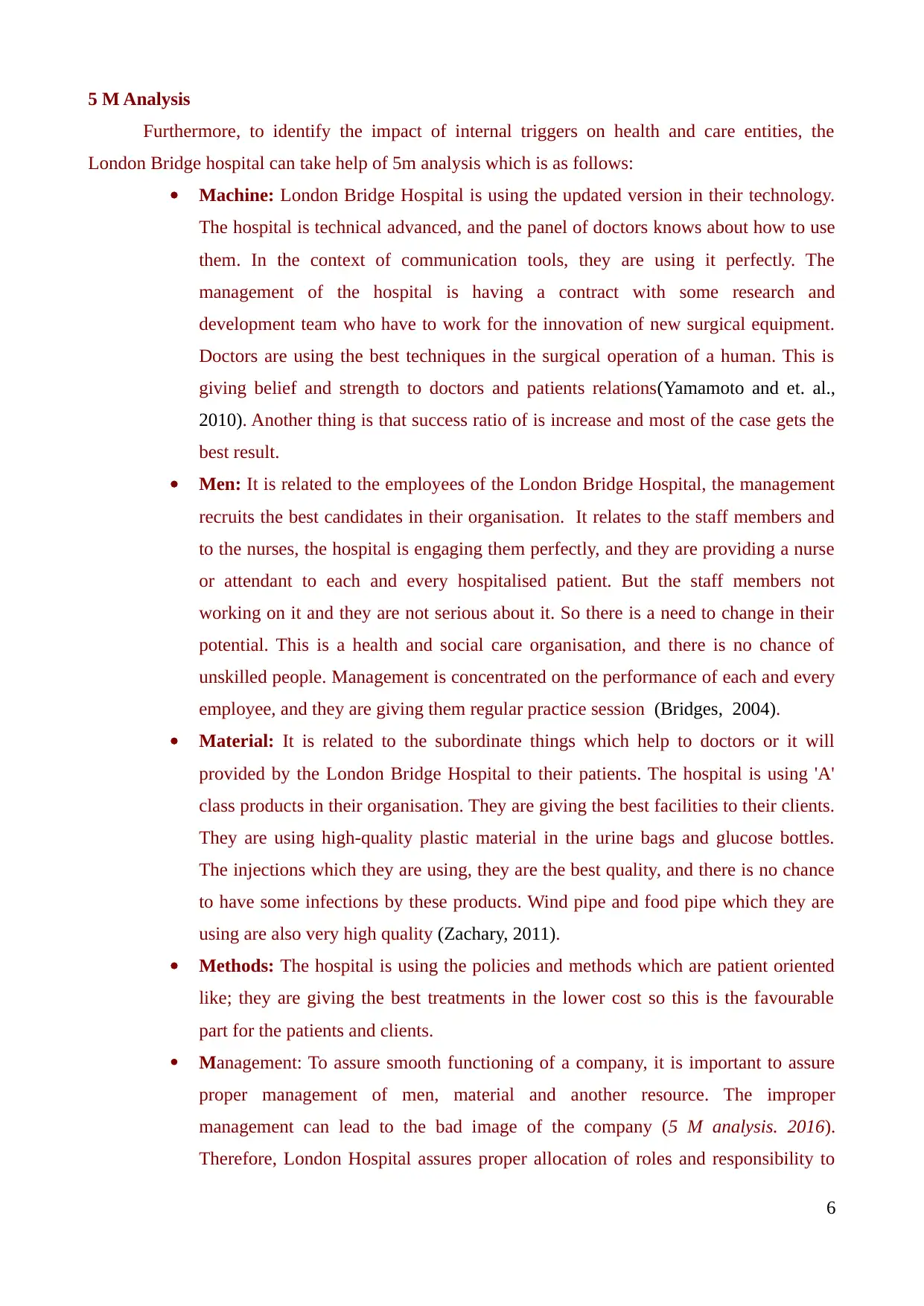
5 M Analysis
Furthermore, to identify the impact of internal triggers on health and care entities, the
London Bridge hospital can take help of 5m analysis which is as follows:
Machine: London Bridge Hospital is using the updated version in their technology.
The hospital is technical advanced, and the panel of doctors knows about how to use
them. In the context of communication tools, they are using it perfectly. The
management of the hospital is having a contract with some research and
development team who have to work for the innovation of new surgical equipment.
Doctors are using the best techniques in the surgical operation of a human. This is
giving belief and strength to doctors and patients relations(Yamamoto and et. al.,
2010). Another thing is that success ratio of is increase and most of the case gets the
best result.
Men: It is related to the employees of the London Bridge Hospital, the management
recruits the best candidates in their organisation. It relates to the staff members and
to the nurses, the hospital is engaging them perfectly, and they are providing a nurse
or attendant to each and every hospitalised patient. But the staff members not
working on it and they are not serious about it. So there is a need to change in their
potential. This is a health and social care organisation, and there is no chance of
unskilled people. Management is concentrated on the performance of each and every
employee, and they are giving them regular practice session (Bridges, 2004).
Material: It is related to the subordinate things which help to doctors or it will
provided by the London Bridge Hospital to their patients. The hospital is using 'A'
class products in their organisation. They are giving the best facilities to their clients.
They are using high-quality plastic material in the urine bags and glucose bottles.
The injections which they are using, they are the best quality, and there is no chance
to have some infections by these products. Wind pipe and food pipe which they are
using are also very high quality (Zachary, 2011).
Methods: The hospital is using the policies and methods which are patient oriented
like; they are giving the best treatments in the lower cost so this is the favourable
part for the patients and clients.
Management: To assure smooth functioning of a company, it is important to assure
proper management of men, material and another resource. The improper
management can lead to the bad image of the company (5 M analysis. 2016).
Therefore, London Hospital assures proper allocation of roles and responsibility to
6
Furthermore, to identify the impact of internal triggers on health and care entities, the
London Bridge hospital can take help of 5m analysis which is as follows:
Machine: London Bridge Hospital is using the updated version in their technology.
The hospital is technical advanced, and the panel of doctors knows about how to use
them. In the context of communication tools, they are using it perfectly. The
management of the hospital is having a contract with some research and
development team who have to work for the innovation of new surgical equipment.
Doctors are using the best techniques in the surgical operation of a human. This is
giving belief and strength to doctors and patients relations(Yamamoto and et. al.,
2010). Another thing is that success ratio of is increase and most of the case gets the
best result.
Men: It is related to the employees of the London Bridge Hospital, the management
recruits the best candidates in their organisation. It relates to the staff members and
to the nurses, the hospital is engaging them perfectly, and they are providing a nurse
or attendant to each and every hospitalised patient. But the staff members not
working on it and they are not serious about it. So there is a need to change in their
potential. This is a health and social care organisation, and there is no chance of
unskilled people. Management is concentrated on the performance of each and every
employee, and they are giving them regular practice session (Bridges, 2004).
Material: It is related to the subordinate things which help to doctors or it will
provided by the London Bridge Hospital to their patients. The hospital is using 'A'
class products in their organisation. They are giving the best facilities to their clients.
They are using high-quality plastic material in the urine bags and glucose bottles.
The injections which they are using, they are the best quality, and there is no chance
to have some infections by these products. Wind pipe and food pipe which they are
using are also very high quality (Zachary, 2011).
Methods: The hospital is using the policies and methods which are patient oriented
like; they are giving the best treatments in the lower cost so this is the favourable
part for the patients and clients.
Management: To assure smooth functioning of a company, it is important to assure
proper management of men, material and another resource. The improper
management can lead to the bad image of the company (5 M analysis. 2016).
Therefore, London Hospital assures proper allocation of roles and responsibility to
6
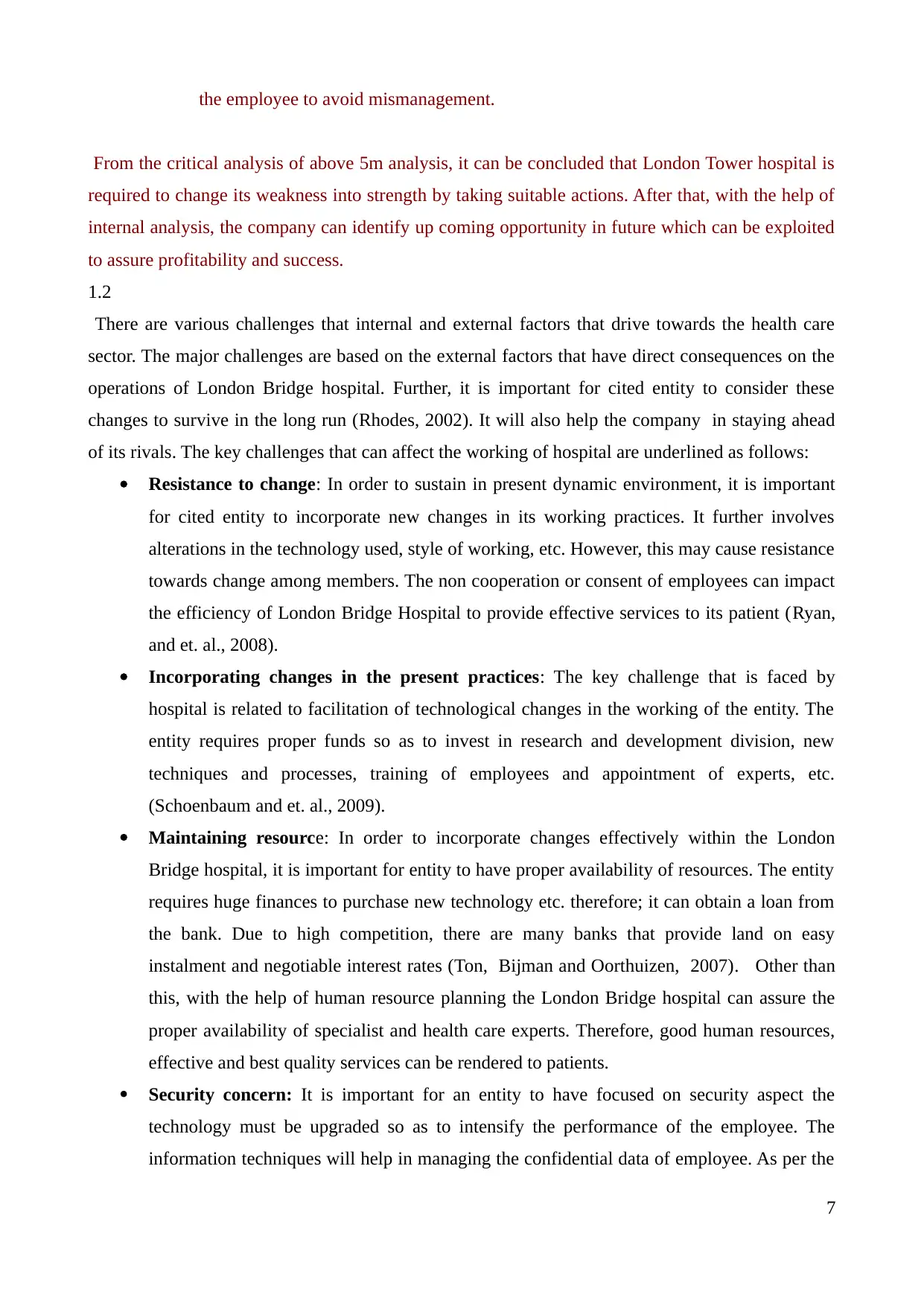
the employee to avoid mismanagement.
From the critical analysis of above 5m analysis, it can be concluded that London Tower hospital is
required to change its weakness into strength by taking suitable actions. After that, with the help of
internal analysis, the company can identify up coming opportunity in future which can be exploited
to assure profitability and success.
1.2
There are various challenges that internal and external factors that drive towards the health care
sector. The major challenges are based on the external factors that have direct consequences on the
operations of London Bridge hospital. Further, it is important for cited entity to consider these
changes to survive in the long run (Rhodes, 2002). It will also help the company in staying ahead
of its rivals. The key challenges that can affect the working of hospital are underlined as follows:
Resistance to change: In order to sustain in present dynamic environment, it is important
for cited entity to incorporate new changes in its working practices. It further involves
alterations in the technology used, style of working, etc. However, this may cause resistance
towards change among members. The non cooperation or consent of employees can impact
the efficiency of London Bridge Hospital to provide effective services to its patient (Ryan,
and et. al., 2008).
Incorporating changes in the present practices: The key challenge that is faced by
hospital is related to facilitation of technological changes in the working of the entity. The
entity requires proper funds so as to invest in research and development division, new
techniques and processes, training of employees and appointment of experts, etc.
(Schoenbaum and et. al., 2009).
Maintaining resource: In order to incorporate changes effectively within the London
Bridge hospital, it is important for entity to have proper availability of resources. The entity
requires huge finances to purchase new technology etc. therefore; it can obtain a loan from
the bank. Due to high competition, there are many banks that provide land on easy
instalment and negotiable interest rates (Ton, Bijman and Oorthuizen, 2007). Other than
this, with the help of human resource planning the London Bridge hospital can assure the
proper availability of specialist and health care experts. Therefore, good human resources,
effective and best quality services can be rendered to patients.
Security concern: It is important for an entity to have focused on security aspect the
technology must be upgraded so as to intensify the performance of the employee. The
information techniques will help in managing the confidential data of employee. As per the
7
From the critical analysis of above 5m analysis, it can be concluded that London Tower hospital is
required to change its weakness into strength by taking suitable actions. After that, with the help of
internal analysis, the company can identify up coming opportunity in future which can be exploited
to assure profitability and success.
1.2
There are various challenges that internal and external factors that drive towards the health care
sector. The major challenges are based on the external factors that have direct consequences on the
operations of London Bridge hospital. Further, it is important for cited entity to consider these
changes to survive in the long run (Rhodes, 2002). It will also help the company in staying ahead
of its rivals. The key challenges that can affect the working of hospital are underlined as follows:
Resistance to change: In order to sustain in present dynamic environment, it is important
for cited entity to incorporate new changes in its working practices. It further involves
alterations in the technology used, style of working, etc. However, this may cause resistance
towards change among members. The non cooperation or consent of employees can impact
the efficiency of London Bridge Hospital to provide effective services to its patient (Ryan,
and et. al., 2008).
Incorporating changes in the present practices: The key challenge that is faced by
hospital is related to facilitation of technological changes in the working of the entity. The
entity requires proper funds so as to invest in research and development division, new
techniques and processes, training of employees and appointment of experts, etc.
(Schoenbaum and et. al., 2009).
Maintaining resource: In order to incorporate changes effectively within the London
Bridge hospital, it is important for entity to have proper availability of resources. The entity
requires huge finances to purchase new technology etc. therefore; it can obtain a loan from
the bank. Due to high competition, there are many banks that provide land on easy
instalment and negotiable interest rates (Ton, Bijman and Oorthuizen, 2007). Other than
this, with the help of human resource planning the London Bridge hospital can assure the
proper availability of specialist and health care experts. Therefore, good human resources,
effective and best quality services can be rendered to patients.
Security concern: It is important for an entity to have focused on security aspect the
technology must be upgraded so as to intensify the performance of the employee. The
information techniques will help in managing the confidential data of employee. As per the
7
Paraphrase This Document
Need a fresh take? Get an instant paraphrase of this document with our AI Paraphraser
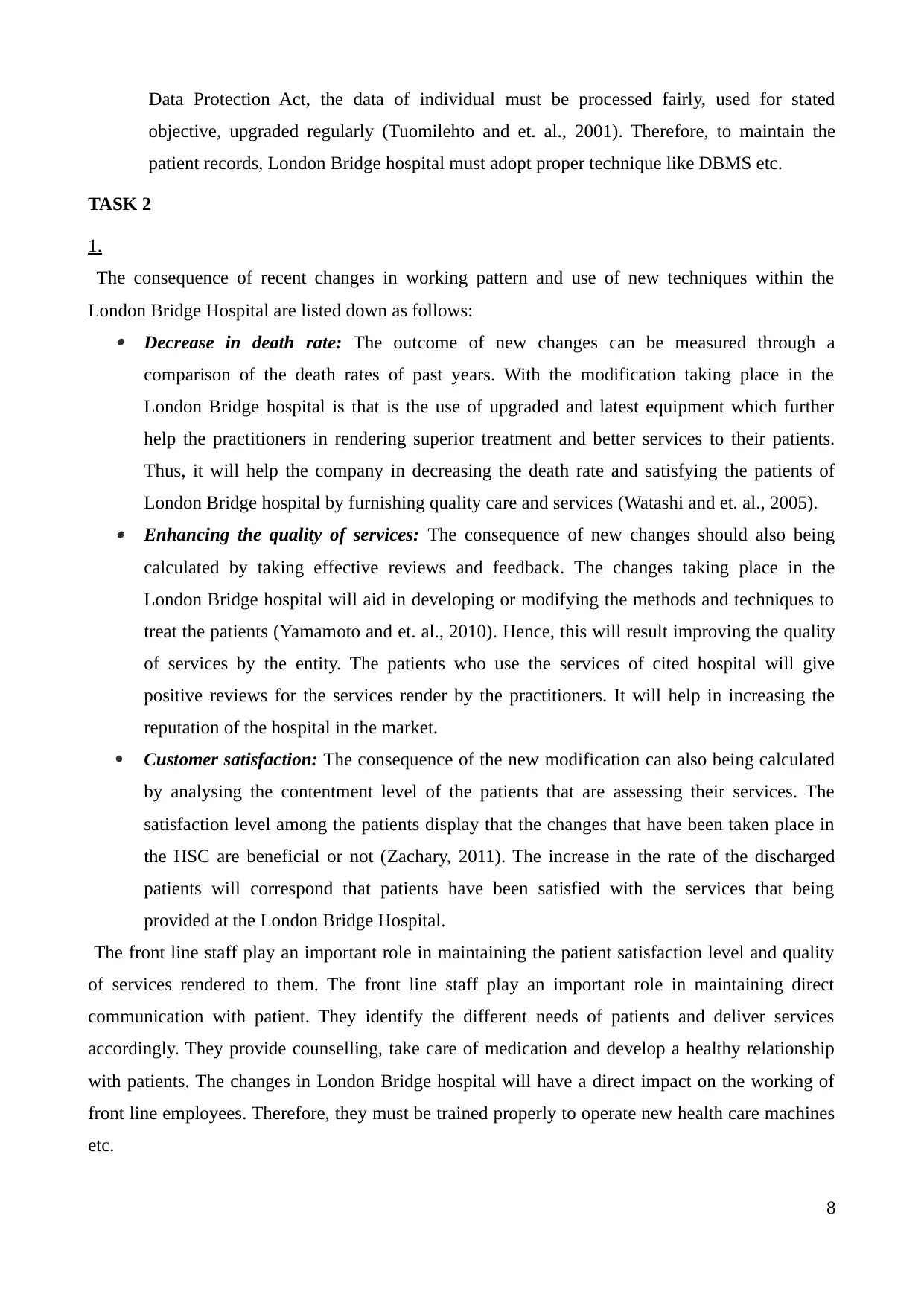
Data Protection Act, the data of individual must be processed fairly, used for stated
objective, upgraded regularly (Tuomilehto and et. al., 2001). Therefore, to maintain the
patient records, London Bridge hospital must adopt proper technique like DBMS etc.
TASK 2
1.
The consequence of recent changes in working pattern and use of new techniques within the
London Bridge Hospital are listed down as follows: Decrease in death rate: The outcome of new changes can be measured through a
comparison of the death rates of past years. With the modification taking place in the
London Bridge hospital is that is the use of upgraded and latest equipment which further
help the practitioners in rendering superior treatment and better services to their patients.
Thus, it will help the company in decreasing the death rate and satisfying the patients of
London Bridge hospital by furnishing quality care and services (Watashi and et. al., 2005). Enhancing the quality of services: The consequence of new changes should also being
calculated by taking effective reviews and feedback. The changes taking place in the
London Bridge hospital will aid in developing or modifying the methods and techniques to
treat the patients (Yamamoto and et. al., 2010). Hence, this will result improving the quality
of services by the entity. The patients who use the services of cited hospital will give
positive reviews for the services render by the practitioners. It will help in increasing the
reputation of the hospital in the market.
Customer satisfaction: The consequence of the new modification can also being calculated
by analysing the contentment level of the patients that are assessing their services. The
satisfaction level among the patients display that the changes that have been taken place in
the HSC are beneficial or not (Zachary, 2011). The increase in the rate of the discharged
patients will correspond that patients have been satisfied with the services that being
provided at the London Bridge Hospital.
The front line staff play an important role in maintaining the patient satisfaction level and quality
of services rendered to them. The front line staff play an important role in maintaining direct
communication with patient. They identify the different needs of patients and deliver services
accordingly. They provide counselling, take care of medication and develop a healthy relationship
with patients. The changes in London Bridge hospital will have a direct impact on the working of
front line employees. Therefore, they must be trained properly to operate new health care machines
etc.
8
objective, upgraded regularly (Tuomilehto and et. al., 2001). Therefore, to maintain the
patient records, London Bridge hospital must adopt proper technique like DBMS etc.
TASK 2
1.
The consequence of recent changes in working pattern and use of new techniques within the
London Bridge Hospital are listed down as follows: Decrease in death rate: The outcome of new changes can be measured through a
comparison of the death rates of past years. With the modification taking place in the
London Bridge hospital is that is the use of upgraded and latest equipment which further
help the practitioners in rendering superior treatment and better services to their patients.
Thus, it will help the company in decreasing the death rate and satisfying the patients of
London Bridge hospital by furnishing quality care and services (Watashi and et. al., 2005). Enhancing the quality of services: The consequence of new changes should also being
calculated by taking effective reviews and feedback. The changes taking place in the
London Bridge hospital will aid in developing or modifying the methods and techniques to
treat the patients (Yamamoto and et. al., 2010). Hence, this will result improving the quality
of services by the entity. The patients who use the services of cited hospital will give
positive reviews for the services render by the practitioners. It will help in increasing the
reputation of the hospital in the market.
Customer satisfaction: The consequence of the new modification can also being calculated
by analysing the contentment level of the patients that are assessing their services. The
satisfaction level among the patients display that the changes that have been taken place in
the HSC are beneficial or not (Zachary, 2011). The increase in the rate of the discharged
patients will correspond that patients have been satisfied with the services that being
provided at the London Bridge Hospital.
The front line staff play an important role in maintaining the patient satisfaction level and quality
of services rendered to them. The front line staff play an important role in maintaining direct
communication with patient. They identify the different needs of patients and deliver services
accordingly. They provide counselling, take care of medication and develop a healthy relationship
with patients. The changes in London Bridge hospital will have a direct impact on the working of
front line employees. Therefore, they must be trained properly to operate new health care machines
etc.
8
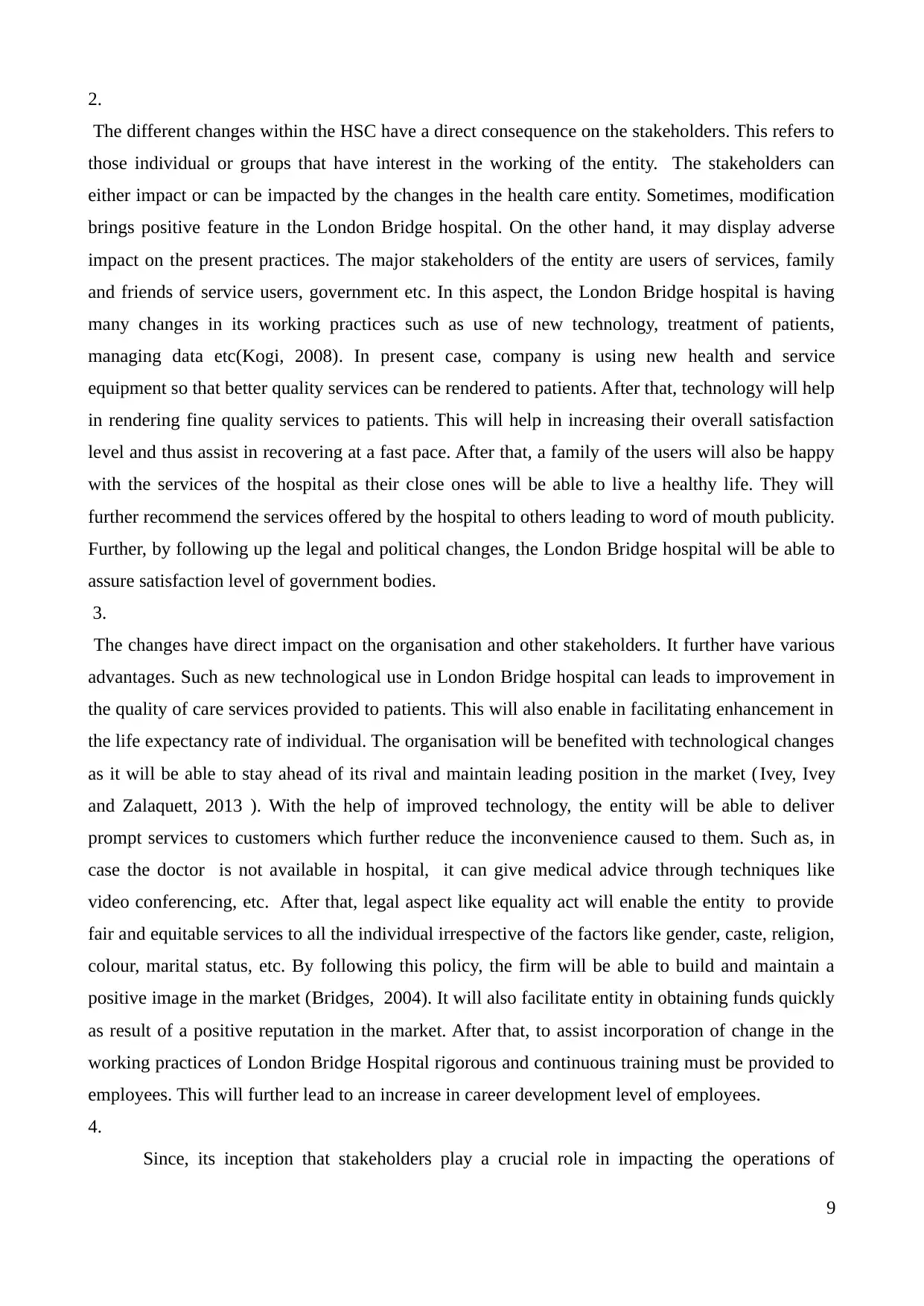
2.
The different changes within the HSC have a direct consequence on the stakeholders. This refers to
those individual or groups that have interest in the working of the entity. The stakeholders can
either impact or can be impacted by the changes in the health care entity. Sometimes, modification
brings positive feature in the London Bridge hospital. On the other hand, it may display adverse
impact on the present practices. The major stakeholders of the entity are users of services, family
and friends of service users, government etc. In this aspect, the London Bridge hospital is having
many changes in its working practices such as use of new technology, treatment of patients,
managing data etc(Kogi, 2008). In present case, company is using new health and service
equipment so that better quality services can be rendered to patients. After that, technology will help
in rendering fine quality services to patients. This will help in increasing their overall satisfaction
level and thus assist in recovering at a fast pace. After that, a family of the users will also be happy
with the services of the hospital as their close ones will be able to live a healthy life. They will
further recommend the services offered by the hospital to others leading to word of mouth publicity.
Further, by following up the legal and political changes, the London Bridge hospital will be able to
assure satisfaction level of government bodies.
3.
The changes have direct impact on the organisation and other stakeholders. It further have various
advantages. Such as new technological use in London Bridge hospital can leads to improvement in
the quality of care services provided to patients. This will also enable in facilitating enhancement in
the life expectancy rate of individual. The organisation will be benefited with technological changes
as it will be able to stay ahead of its rival and maintain leading position in the market ( Ivey, Ivey
and Zalaquett, 2013 ). With the help of improved technology, the entity will be able to deliver
prompt services to customers which further reduce the inconvenience caused to them. Such as, in
case the doctor is not available in hospital, it can give medical advice through techniques like
video conferencing, etc. After that, legal aspect like equality act will enable the entity to provide
fair and equitable services to all the individual irrespective of the factors like gender, caste, religion,
colour, marital status, etc. By following this policy, the firm will be able to build and maintain a
positive image in the market (Bridges, 2004). It will also facilitate entity in obtaining funds quickly
as result of a positive reputation in the market. After that, to assist incorporation of change in the
working practices of London Bridge Hospital rigorous and continuous training must be provided to
employees. This will further lead to an increase in career development level of employees.
4.
Since, its inception that stakeholders play a crucial role in impacting the operations of
9
The different changes within the HSC have a direct consequence on the stakeholders. This refers to
those individual or groups that have interest in the working of the entity. The stakeholders can
either impact or can be impacted by the changes in the health care entity. Sometimes, modification
brings positive feature in the London Bridge hospital. On the other hand, it may display adverse
impact on the present practices. The major stakeholders of the entity are users of services, family
and friends of service users, government etc. In this aspect, the London Bridge hospital is having
many changes in its working practices such as use of new technology, treatment of patients,
managing data etc(Kogi, 2008). In present case, company is using new health and service
equipment so that better quality services can be rendered to patients. After that, technology will help
in rendering fine quality services to patients. This will help in increasing their overall satisfaction
level and thus assist in recovering at a fast pace. After that, a family of the users will also be happy
with the services of the hospital as their close ones will be able to live a healthy life. They will
further recommend the services offered by the hospital to others leading to word of mouth publicity.
Further, by following up the legal and political changes, the London Bridge hospital will be able to
assure satisfaction level of government bodies.
3.
The changes have direct impact on the organisation and other stakeholders. It further have various
advantages. Such as new technological use in London Bridge hospital can leads to improvement in
the quality of care services provided to patients. This will also enable in facilitating enhancement in
the life expectancy rate of individual. The organisation will be benefited with technological changes
as it will be able to stay ahead of its rival and maintain leading position in the market ( Ivey, Ivey
and Zalaquett, 2013 ). With the help of improved technology, the entity will be able to deliver
prompt services to customers which further reduce the inconvenience caused to them. Such as, in
case the doctor is not available in hospital, it can give medical advice through techniques like
video conferencing, etc. After that, legal aspect like equality act will enable the entity to provide
fair and equitable services to all the individual irrespective of the factors like gender, caste, religion,
colour, marital status, etc. By following this policy, the firm will be able to build and maintain a
positive image in the market (Bridges, 2004). It will also facilitate entity in obtaining funds quickly
as result of a positive reputation in the market. After that, to assist incorporation of change in the
working practices of London Bridge Hospital rigorous and continuous training must be provided to
employees. This will further lead to an increase in career development level of employees.
4.
Since, its inception that stakeholders play a crucial role in impacting the operations of
9
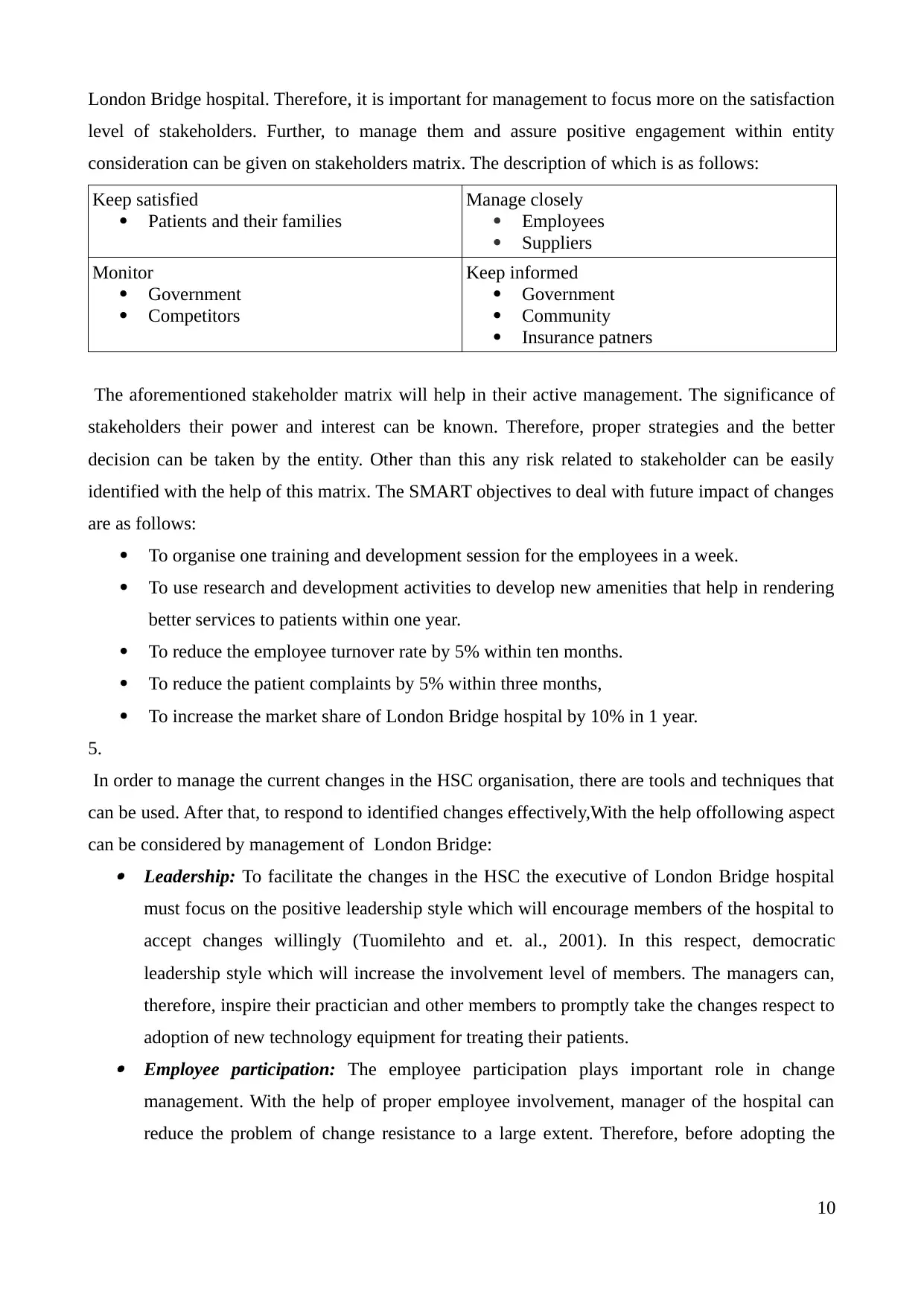
London Bridge hospital. Therefore, it is important for management to focus more on the satisfaction
level of stakeholders. Further, to manage them and assure positive engagement within entity
consideration can be given on stakeholders matrix. The description of which is as follows:
Keep satisfied
Patients and their families
Manage closely
Employees
Suppliers
Monitor
Government
Competitors
Keep informed
Government
Community
Insurance patners
The aforementioned stakeholder matrix will help in their active management. The significance of
stakeholders their power and interest can be known. Therefore, proper strategies and the better
decision can be taken by the entity. Other than this any risk related to stakeholder can be easily
identified with the help of this matrix. The SMART objectives to deal with future impact of changes
are as follows:
To organise one training and development session for the employees in a week.
To use research and development activities to develop new amenities that help in rendering
better services to patients within one year.
To reduce the employee turnover rate by 5% within ten months.
To reduce the patient complaints by 5% within three months,
To increase the market share of London Bridge hospital by 10% in 1 year.
5.
In order to manage the current changes in the HSC organisation, there are tools and techniques that
can be used. After that, to respond to identified changes effectively,With the help offollowing aspect
can be considered by management of London Bridge: Leadership: To facilitate the changes in the HSC the executive of London Bridge hospital
must focus on the positive leadership style which will encourage members of the hospital to
accept changes willingly (Tuomilehto and et. al., 2001). In this respect, democratic
leadership style which will increase the involvement level of members. The managers can,
therefore, inspire their practician and other members to promptly take the changes respect to
adoption of new technology equipment for treating their patients. Employee participation: The employee participation plays important role in change
management. With the help of proper employee involvement, manager of the hospital can
reduce the problem of change resistance to a large extent. Therefore, before adopting the
10
level of stakeholders. Further, to manage them and assure positive engagement within entity
consideration can be given on stakeholders matrix. The description of which is as follows:
Keep satisfied
Patients and their families
Manage closely
Employees
Suppliers
Monitor
Government
Competitors
Keep informed
Government
Community
Insurance patners
The aforementioned stakeholder matrix will help in their active management. The significance of
stakeholders their power and interest can be known. Therefore, proper strategies and the better
decision can be taken by the entity. Other than this any risk related to stakeholder can be easily
identified with the help of this matrix. The SMART objectives to deal with future impact of changes
are as follows:
To organise one training and development session for the employees in a week.
To use research and development activities to develop new amenities that help in rendering
better services to patients within one year.
To reduce the employee turnover rate by 5% within ten months.
To reduce the patient complaints by 5% within three months,
To increase the market share of London Bridge hospital by 10% in 1 year.
5.
In order to manage the current changes in the HSC organisation, there are tools and techniques that
can be used. After that, to respond to identified changes effectively,With the help offollowing aspect
can be considered by management of London Bridge: Leadership: To facilitate the changes in the HSC the executive of London Bridge hospital
must focus on the positive leadership style which will encourage members of the hospital to
accept changes willingly (Tuomilehto and et. al., 2001). In this respect, democratic
leadership style which will increase the involvement level of members. The managers can,
therefore, inspire their practician and other members to promptly take the changes respect to
adoption of new technology equipment for treating their patients. Employee participation: The employee participation plays important role in change
management. With the help of proper employee involvement, manager of the hospital can
reduce the problem of change resistance to a large extent. Therefore, before adopting the
10
Secure Best Marks with AI Grader
Need help grading? Try our AI Grader for instant feedback on your assignments.
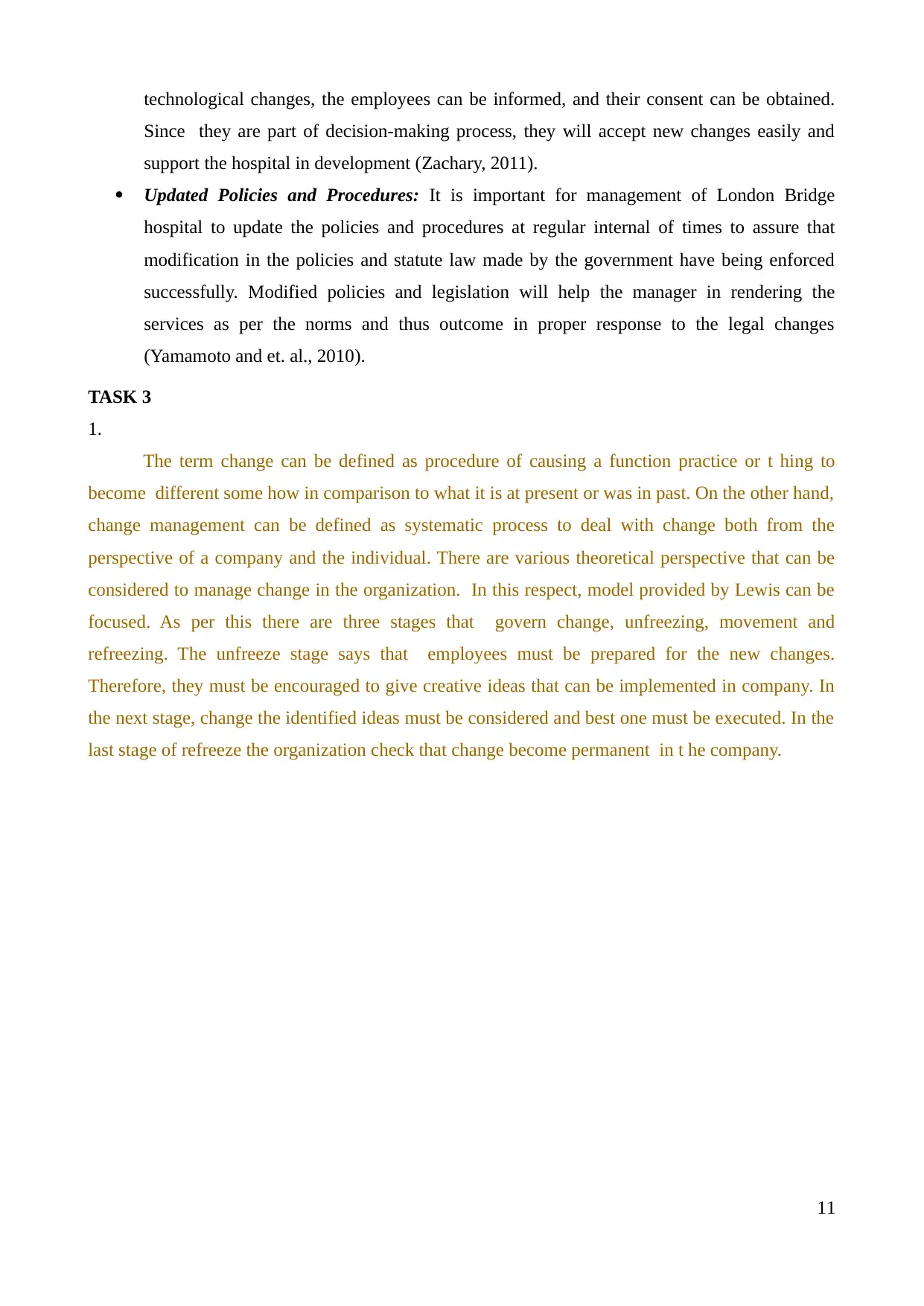
technological changes, the employees can be informed, and their consent can be obtained.
Since they are part of decision-making process, they will accept new changes easily and
support the hospital in development (Zachary, 2011).
Updated Policies and Procedures: It is important for management of London Bridge
hospital to update the policies and procedures at regular internal of times to assure that
modification in the policies and statute law made by the government have being enforced
successfully. Modified policies and legislation will help the manager in rendering the
services as per the norms and thus outcome in proper response to the legal changes
(Yamamoto and et. al., 2010).
TASK 3
1.
The term change can be defined as procedure of causing a function practice or t hing to
become different some how in comparison to what it is at present or was in past. On the other hand,
change management can be defined as systematic process to deal with change both from the
perspective of a company and the individual. There are various theoretical perspective that can be
considered to manage change in the organization. In this respect, model provided by Lewis can be
focused. As per this there are three stages that govern change, unfreezing, movement and
refreezing. The unfreeze stage says that employees must be prepared for the new changes.
Therefore, they must be encouraged to give creative ideas that can be implemented in company. In
the next stage, change the identified ideas must be considered and best one must be executed. In the
last stage of refreeze the organization check that change become permanent in t he company.
11
Since they are part of decision-making process, they will accept new changes easily and
support the hospital in development (Zachary, 2011).
Updated Policies and Procedures: It is important for management of London Bridge
hospital to update the policies and procedures at regular internal of times to assure that
modification in the policies and statute law made by the government have being enforced
successfully. Modified policies and legislation will help the manager in rendering the
services as per the norms and thus outcome in proper response to the legal changes
(Yamamoto and et. al., 2010).
TASK 3
1.
The term change can be defined as procedure of causing a function practice or t hing to
become different some how in comparison to what it is at present or was in past. On the other hand,
change management can be defined as systematic process to deal with change both from the
perspective of a company and the individual. There are various theoretical perspective that can be
considered to manage change in the organization. In this respect, model provided by Lewis can be
focused. As per this there are three stages that govern change, unfreezing, movement and
refreezing. The unfreeze stage says that employees must be prepared for the new changes.
Therefore, they must be encouraged to give creative ideas that can be implemented in company. In
the next stage, change the identified ideas must be considered and best one must be executed. In the
last stage of refreeze the organization check that change become permanent in t he company.
11
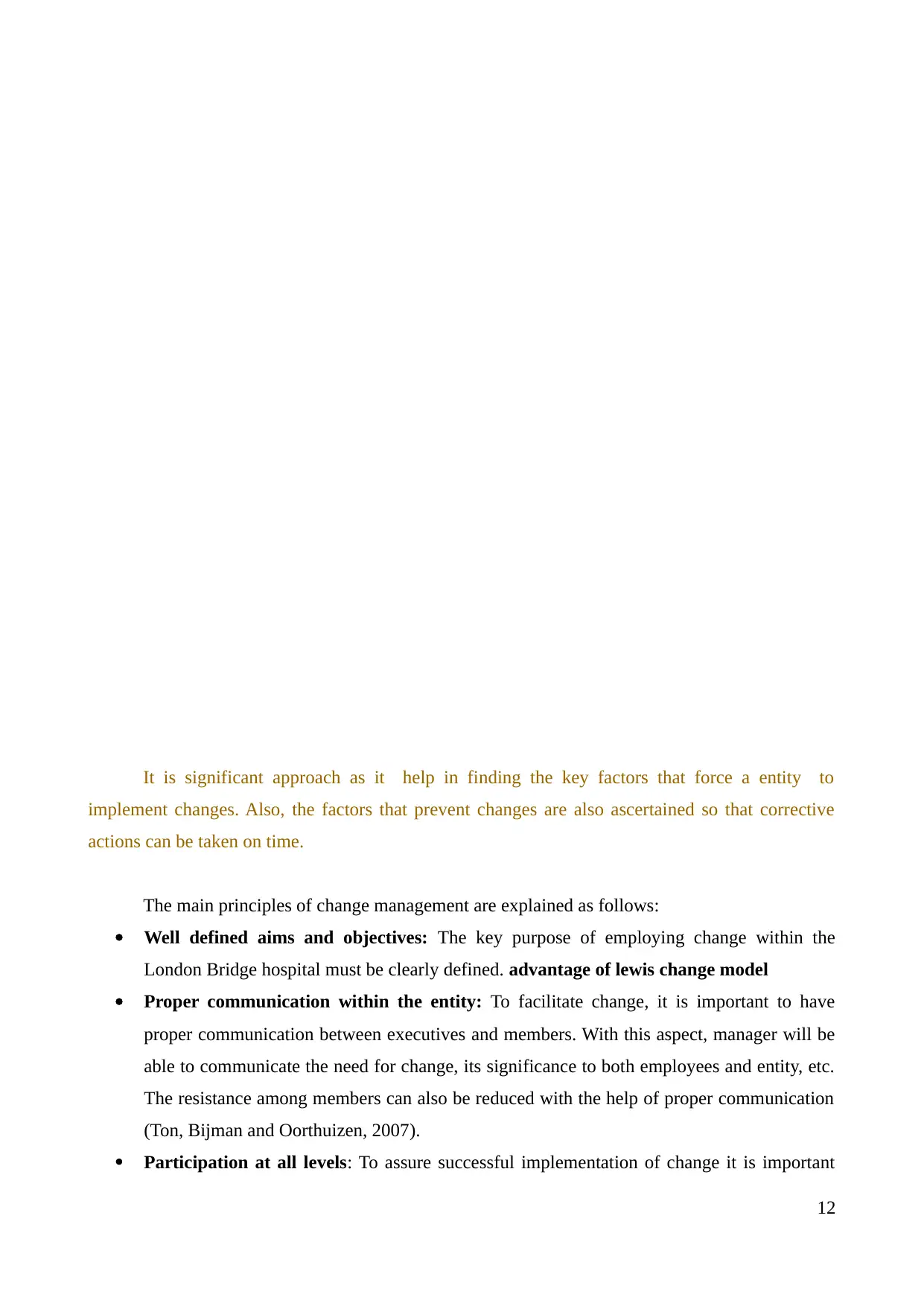
It is significant approach as it help in finding the key factors that force a entity to
implement changes. Also, the factors that prevent changes are also ascertained so that corrective
actions can be taken on time.
The main principles of change management are explained as follows:
Well defined aims and objectives: The key purpose of employing change within the
London Bridge hospital must be clearly defined. advantage of lewis change model
Proper communication within the entity: To facilitate change, it is important to have
proper communication between executives and members. With this aspect, manager will be
able to communicate the need for change, its significance to both employees and entity, etc.
The resistance among members can also be reduced with the help of proper communication
(Ton, Bijman and Oorthuizen, 2007).
Participation at all levels: To assure successful implementation of change it is important
12
implement changes. Also, the factors that prevent changes are also ascertained so that corrective
actions can be taken on time.
The main principles of change management are explained as follows:
Well defined aims and objectives: The key purpose of employing change within the
London Bridge hospital must be clearly defined. advantage of lewis change model
Proper communication within the entity: To facilitate change, it is important to have
proper communication between executives and members. With this aspect, manager will be
able to communicate the need for change, its significance to both employees and entity, etc.
The resistance among members can also be reduced with the help of proper communication
(Ton, Bijman and Oorthuizen, 2007).
Participation at all levels: To assure successful implementation of change it is important
12
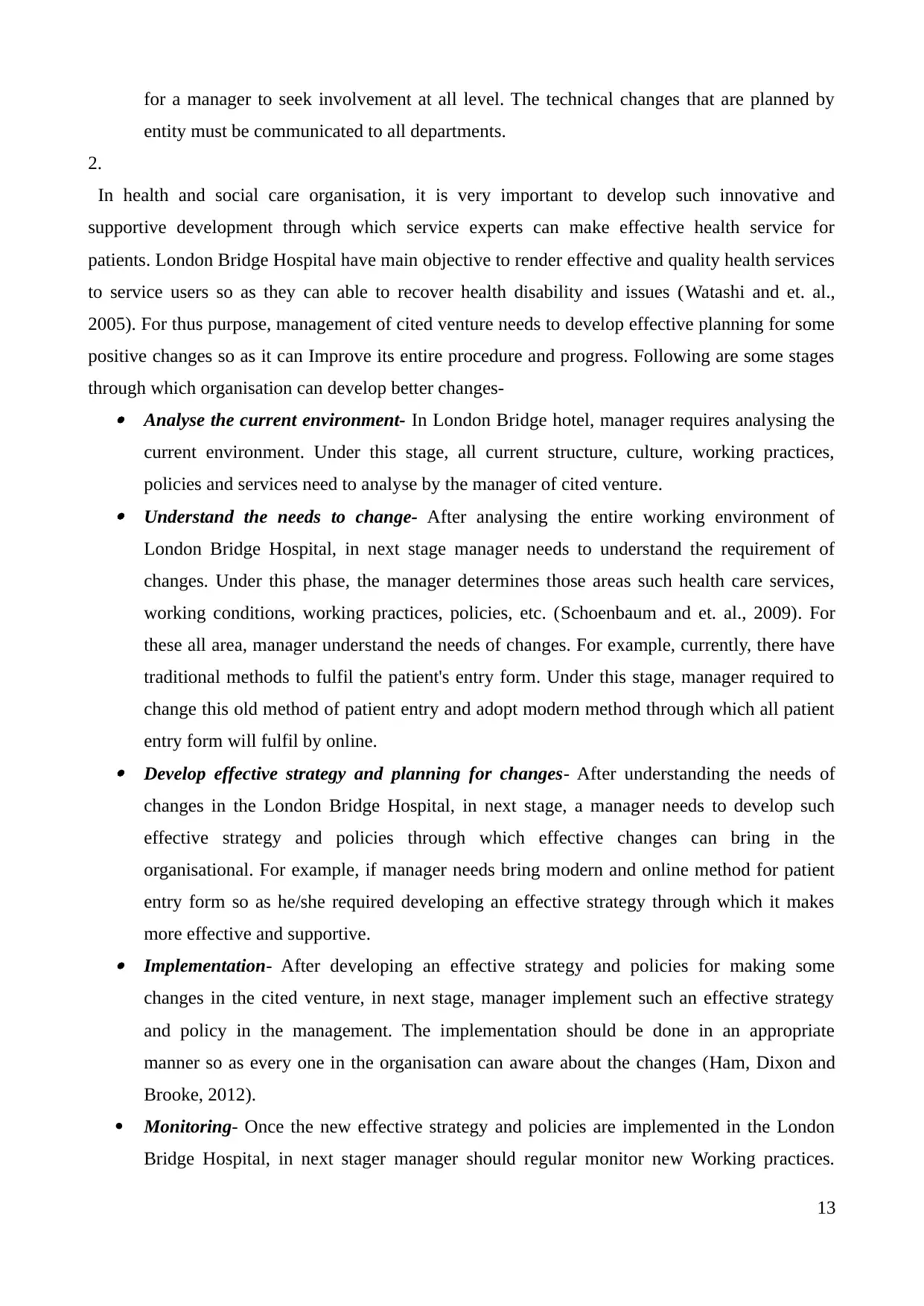
for a manager to seek involvement at all level. The technical changes that are planned by
entity must be communicated to all departments.
2.
In health and social care organisation, it is very important to develop such innovative and
supportive development through which service experts can make effective health service for
patients. London Bridge Hospital have main objective to render effective and quality health services
to service users so as they can able to recover health disability and issues (Watashi and et. al.,
2005). For thus purpose, management of cited venture needs to develop effective planning for some
positive changes so as it can Improve its entire procedure and progress. Following are some stages
through which organisation can develop better changes- Analyse the current environment- In London Bridge hotel, manager requires analysing the
current environment. Under this stage, all current structure, culture, working practices,
policies and services need to analyse by the manager of cited venture. Understand the needs to change- After analysing the entire working environment of
London Bridge Hospital, in next stage manager needs to understand the requirement of
changes. Under this phase, the manager determines those areas such health care services,
working conditions, working practices, policies, etc. (Schoenbaum and et. al., 2009). For
these all area, manager understand the needs of changes. For example, currently, there have
traditional methods to fulfil the patient's entry form. Under this stage, manager required to
change this old method of patient entry and adopt modern method through which all patient
entry form will fulfil by online. Develop effective strategy and planning for changes- After understanding the needs of
changes in the London Bridge Hospital, in next stage, a manager needs to develop such
effective strategy and policies through which effective changes can bring in the
organisational. For example, if manager needs bring modern and online method for patient
entry form so as he/she required developing an effective strategy through which it makes
more effective and supportive. Implementation- After developing an effective strategy and policies for making some
changes in the cited venture, in next stage, manager implement such an effective strategy
and policy in the management. The implementation should be done in an appropriate
manner so as every one in the organisation can aware about the changes (Ham, Dixon and
Brooke, 2012).
Monitoring- Once the new effective strategy and policies are implemented in the London
Bridge Hospital, in next stager manager should regular monitor new Working practices.
13
entity must be communicated to all departments.
2.
In health and social care organisation, it is very important to develop such innovative and
supportive development through which service experts can make effective health service for
patients. London Bridge Hospital have main objective to render effective and quality health services
to service users so as they can able to recover health disability and issues (Watashi and et. al.,
2005). For thus purpose, management of cited venture needs to develop effective planning for some
positive changes so as it can Improve its entire procedure and progress. Following are some stages
through which organisation can develop better changes- Analyse the current environment- In London Bridge hotel, manager requires analysing the
current environment. Under this stage, all current structure, culture, working practices,
policies and services need to analyse by the manager of cited venture. Understand the needs to change- After analysing the entire working environment of
London Bridge Hospital, in next stage manager needs to understand the requirement of
changes. Under this phase, the manager determines those areas such health care services,
working conditions, working practices, policies, etc. (Schoenbaum and et. al., 2009). For
these all area, manager understand the needs of changes. For example, currently, there have
traditional methods to fulfil the patient's entry form. Under this stage, manager required to
change this old method of patient entry and adopt modern method through which all patient
entry form will fulfil by online. Develop effective strategy and planning for changes- After understanding the needs of
changes in the London Bridge Hospital, in next stage, a manager needs to develop such
effective strategy and policies through which effective changes can bring in the
organisational. For example, if manager needs bring modern and online method for patient
entry form so as he/she required developing an effective strategy through which it makes
more effective and supportive. Implementation- After developing an effective strategy and policies for making some
changes in the cited venture, in next stage, manager implement such an effective strategy
and policy in the management. The implementation should be done in an appropriate
manner so as every one in the organisation can aware about the changes (Ham, Dixon and
Brooke, 2012).
Monitoring- Once the new effective strategy and policies are implemented in the London
Bridge Hospital, in next stager manager should regular monitor new Working practices.
13
Paraphrase This Document
Need a fresh take? Get an instant paraphrase of this document with our AI Paraphraser
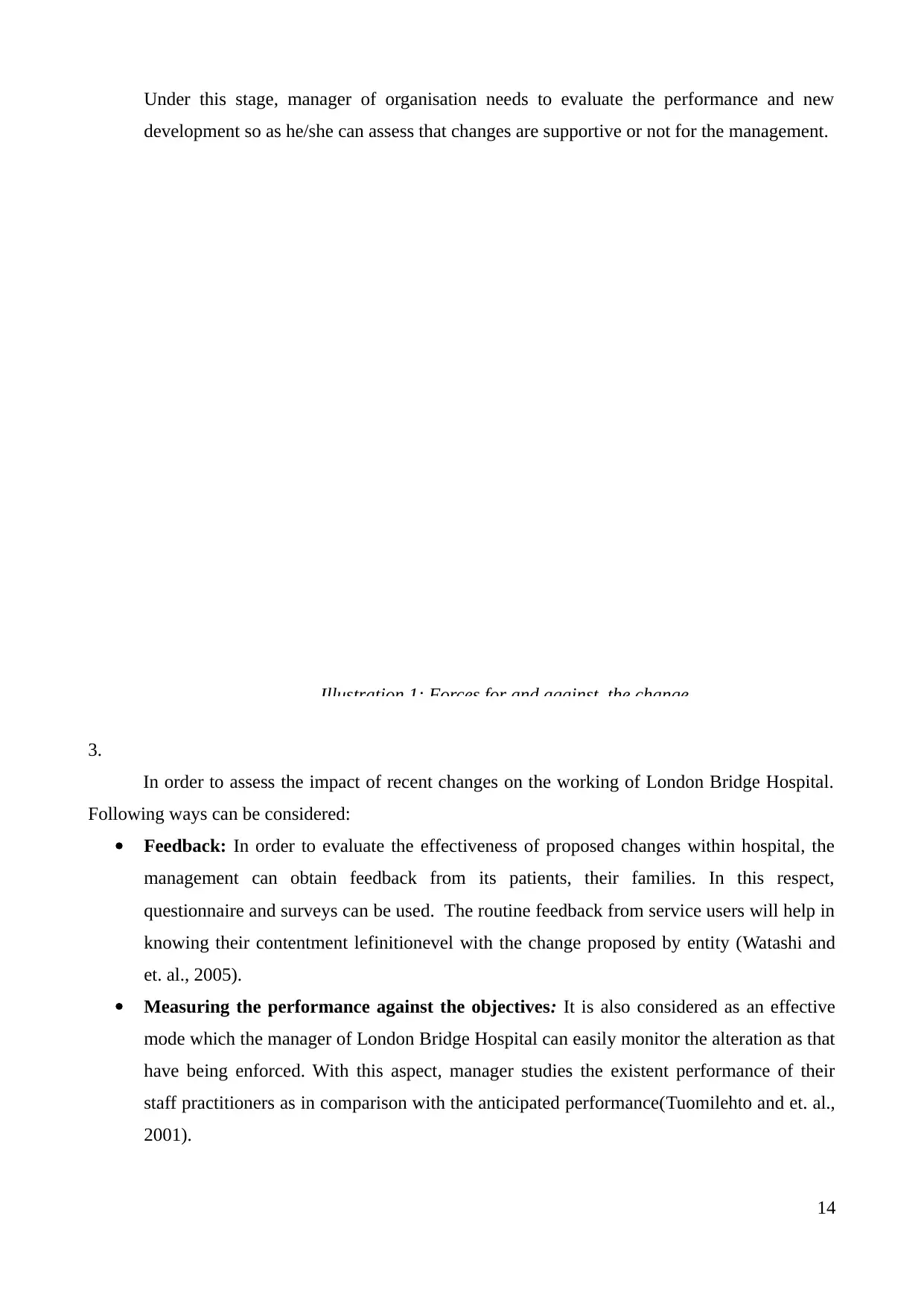
Under this stage, manager of organisation needs to evaluate the performance and new
development so as he/she can assess that changes are supportive or not for the management.
Illustration 1: Forces for and against the change
3.
In order to assess the impact of recent changes on the working of London Bridge Hospital.
Following ways can be considered:
Feedback: In order to evaluate the effectiveness of proposed changes within hospital, the
management can obtain feedback from its patients, their families. In this respect,
questionnaire and surveys can be used. The routine feedback from service users will help in
knowing their contentment lefinitionevel with the change proposed by entity (Watashi and
et. al., 2005).
Measuring the performance against the objectives: It is also considered as an effective
mode which the manager of London Bridge Hospital can easily monitor the alteration as that
have being enforced. With this aspect, manager studies the existent performance of their
staff practitioners as in comparison with the anticipated performance(Tuomilehto and et. al.,
2001).
14
development so as he/she can assess that changes are supportive or not for the management.
Illustration 1: Forces for and against the change
3.
In order to assess the impact of recent changes on the working of London Bridge Hospital.
Following ways can be considered:
Feedback: In order to evaluate the effectiveness of proposed changes within hospital, the
management can obtain feedback from its patients, their families. In this respect,
questionnaire and surveys can be used. The routine feedback from service users will help in
knowing their contentment lefinitionevel with the change proposed by entity (Watashi and
et. al., 2005).
Measuring the performance against the objectives: It is also considered as an effective
mode which the manager of London Bridge Hospital can easily monitor the alteration as that
have being enforced. With this aspect, manager studies the existent performance of their
staff practitioners as in comparison with the anticipated performance(Tuomilehto and et. al.,
2001).
14
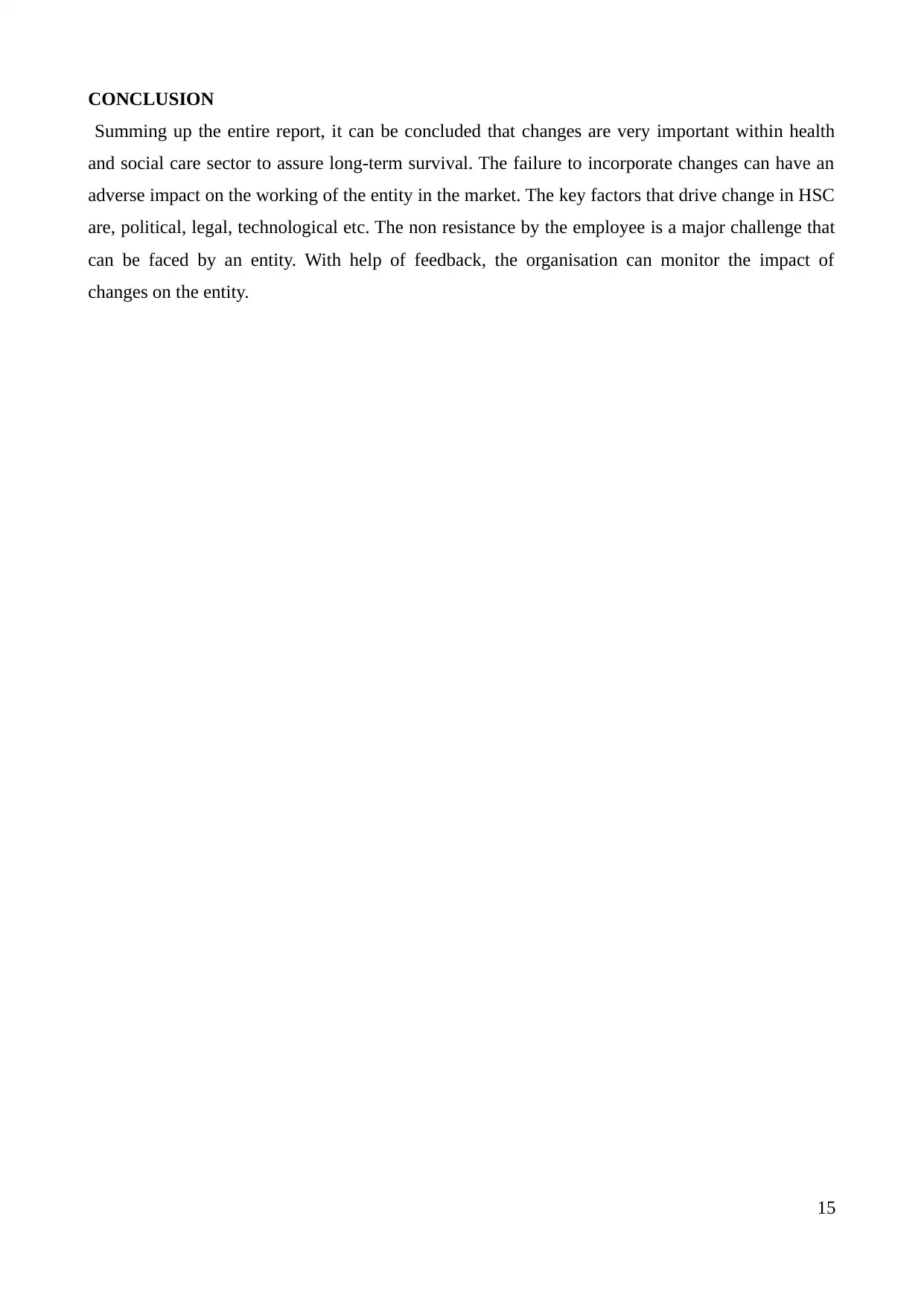
CONCLUSION
Summing up the entire report, it can be concluded that changes are very important within health
and social care sector to assure long-term survival. The failure to incorporate changes can have an
adverse impact on the working of the entity in the market. The key factors that drive change in HSC
are, political, legal, technological etc. The non resistance by the employee is a major challenge that
can be faced by an entity. With help of feedback, the organisation can monitor the impact of
changes on the entity.
15
Summing up the entire report, it can be concluded that changes are very important within health
and social care sector to assure long-term survival. The failure to incorporate changes can have an
adverse impact on the working of the entity in the market. The key factors that drive change in HSC
are, political, legal, technological etc. The non resistance by the employee is a major challenge that
can be faced by an entity. With help of feedback, the organisation can monitor the impact of
changes on the entity.
15
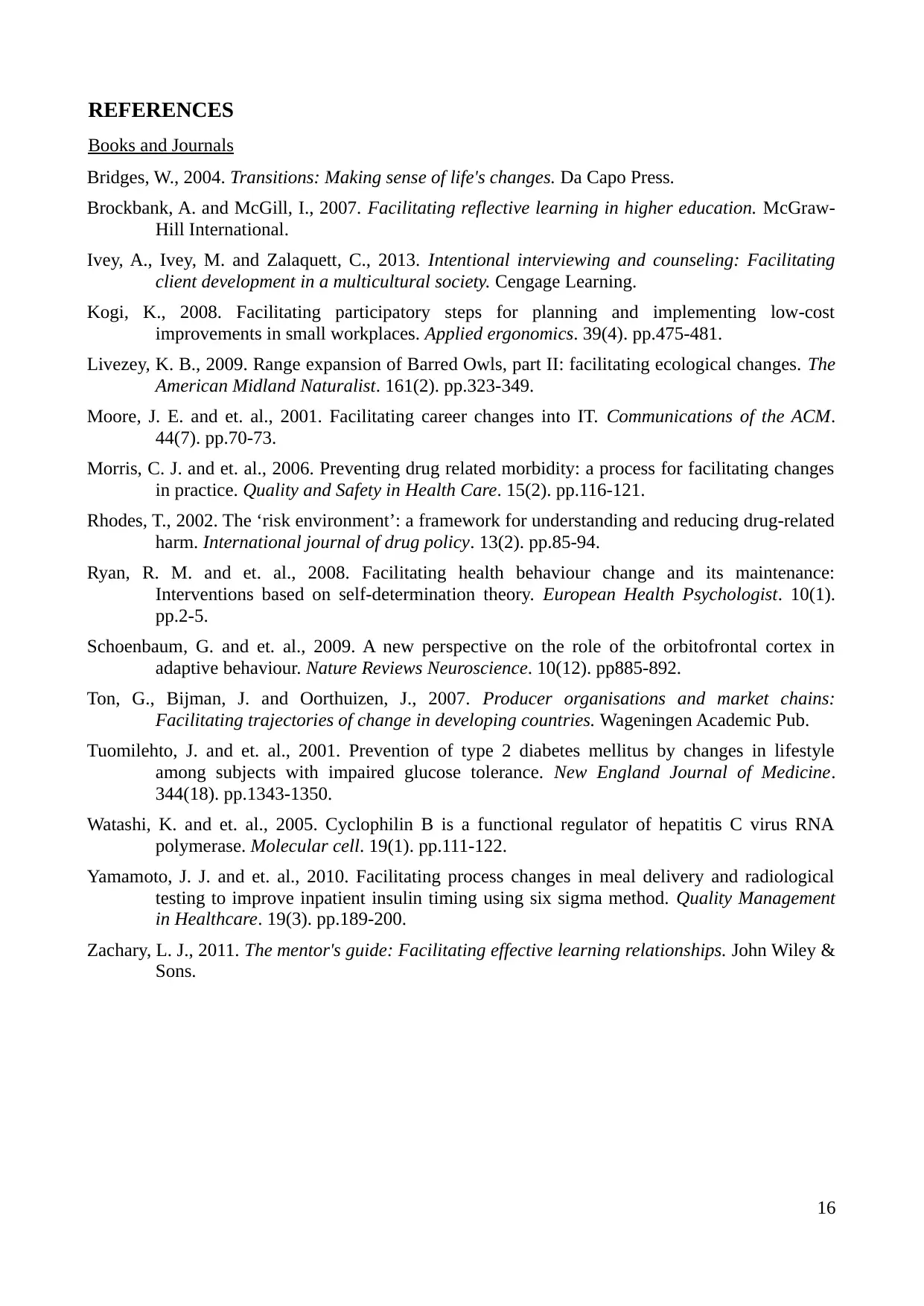
REFERENCES
Books and Journals
Bridges, W., 2004. Transitions: Making sense of life's changes. Da Capo Press.
Brockbank, A. and McGill, I., 2007. Facilitating reflective learning in higher education. McGraw-
Hill International.
Ivey, A., Ivey, M. and Zalaquett, C., 2013. Intentional interviewing and counseling: Facilitating
client development in a multicultural society. Cengage Learning.
Kogi, K., 2008. Facilitating participatory steps for planning and implementing low-cost
improvements in small workplaces. Applied ergonomics. 39(4). pp.475-481.
Livezey, K. B., 2009. Range expansion of Barred Owls, part II: facilitating ecological changes. The
American Midland Naturalist. 161(2). pp.323-349.
Moore, J. E. and et. al., 2001. Facilitating career changes into IT. Communications of the ACM.
44(7). pp.70-73.
Morris, C. J. and et. al., 2006. Preventing drug related morbidity: a process for facilitating changes
in practice. Quality and Safety in Health Care. 15(2). pp.116-121.
Rhodes, T., 2002. The ‘risk environment’: a framework for understanding and reducing drug-related
harm. International journal of drug policy. 13(2). pp.85-94.
Ryan, R. M. and et. al., 2008. Facilitating health behaviour change and its maintenance:
Interventions based on self-determination theory. European Health Psychologist. 10(1).
pp.2-5.
Schoenbaum, G. and et. al., 2009. A new perspective on the role of the orbitofrontal cortex in
adaptive behaviour. Nature Reviews Neuroscience. 10(12). pp885-892.
Ton, G., Bijman, J. and Oorthuizen, J., 2007. Producer organisations and market chains:
Facilitating trajectories of change in developing countries. Wageningen Academic Pub.
Tuomilehto, J. and et. al., 2001. Prevention of type 2 diabetes mellitus by changes in lifestyle
among subjects with impaired glucose tolerance. New England Journal of Medicine.
344(18). pp.1343-1350.
Watashi, K. and et. al., 2005. Cyclophilin B is a functional regulator of hepatitis C virus RNA
polymerase. Molecular cell. 19(1). pp.111-122.
Yamamoto, J. J. and et. al., 2010. Facilitating process changes in meal delivery and radiological
testing to improve inpatient insulin timing using six sigma method. Quality Management
in Healthcare. 19(3). pp.189-200.
Zachary, L. J., 2011. The mentor's guide: Facilitating effective learning relationships. John Wiley &
Sons.
16
Books and Journals
Bridges, W., 2004. Transitions: Making sense of life's changes. Da Capo Press.
Brockbank, A. and McGill, I., 2007. Facilitating reflective learning in higher education. McGraw-
Hill International.
Ivey, A., Ivey, M. and Zalaquett, C., 2013. Intentional interviewing and counseling: Facilitating
client development in a multicultural society. Cengage Learning.
Kogi, K., 2008. Facilitating participatory steps for planning and implementing low-cost
improvements in small workplaces. Applied ergonomics. 39(4). pp.475-481.
Livezey, K. B., 2009. Range expansion of Barred Owls, part II: facilitating ecological changes. The
American Midland Naturalist. 161(2). pp.323-349.
Moore, J. E. and et. al., 2001. Facilitating career changes into IT. Communications of the ACM.
44(7). pp.70-73.
Morris, C. J. and et. al., 2006. Preventing drug related morbidity: a process for facilitating changes
in practice. Quality and Safety in Health Care. 15(2). pp.116-121.
Rhodes, T., 2002. The ‘risk environment’: a framework for understanding and reducing drug-related
harm. International journal of drug policy. 13(2). pp.85-94.
Ryan, R. M. and et. al., 2008. Facilitating health behaviour change and its maintenance:
Interventions based on self-determination theory. European Health Psychologist. 10(1).
pp.2-5.
Schoenbaum, G. and et. al., 2009. A new perspective on the role of the orbitofrontal cortex in
adaptive behaviour. Nature Reviews Neuroscience. 10(12). pp885-892.
Ton, G., Bijman, J. and Oorthuizen, J., 2007. Producer organisations and market chains:
Facilitating trajectories of change in developing countries. Wageningen Academic Pub.
Tuomilehto, J. and et. al., 2001. Prevention of type 2 diabetes mellitus by changes in lifestyle
among subjects with impaired glucose tolerance. New England Journal of Medicine.
344(18). pp.1343-1350.
Watashi, K. and et. al., 2005. Cyclophilin B is a functional regulator of hepatitis C virus RNA
polymerase. Molecular cell. 19(1). pp.111-122.
Yamamoto, J. J. and et. al., 2010. Facilitating process changes in meal delivery and radiological
testing to improve inpatient insulin timing using six sigma method. Quality Management
in Healthcare. 19(3). pp.189-200.
Zachary, L. J., 2011. The mentor's guide: Facilitating effective learning relationships. John Wiley &
Sons.
16
Secure Best Marks with AI Grader
Need help grading? Try our AI Grader for instant feedback on your assignments.
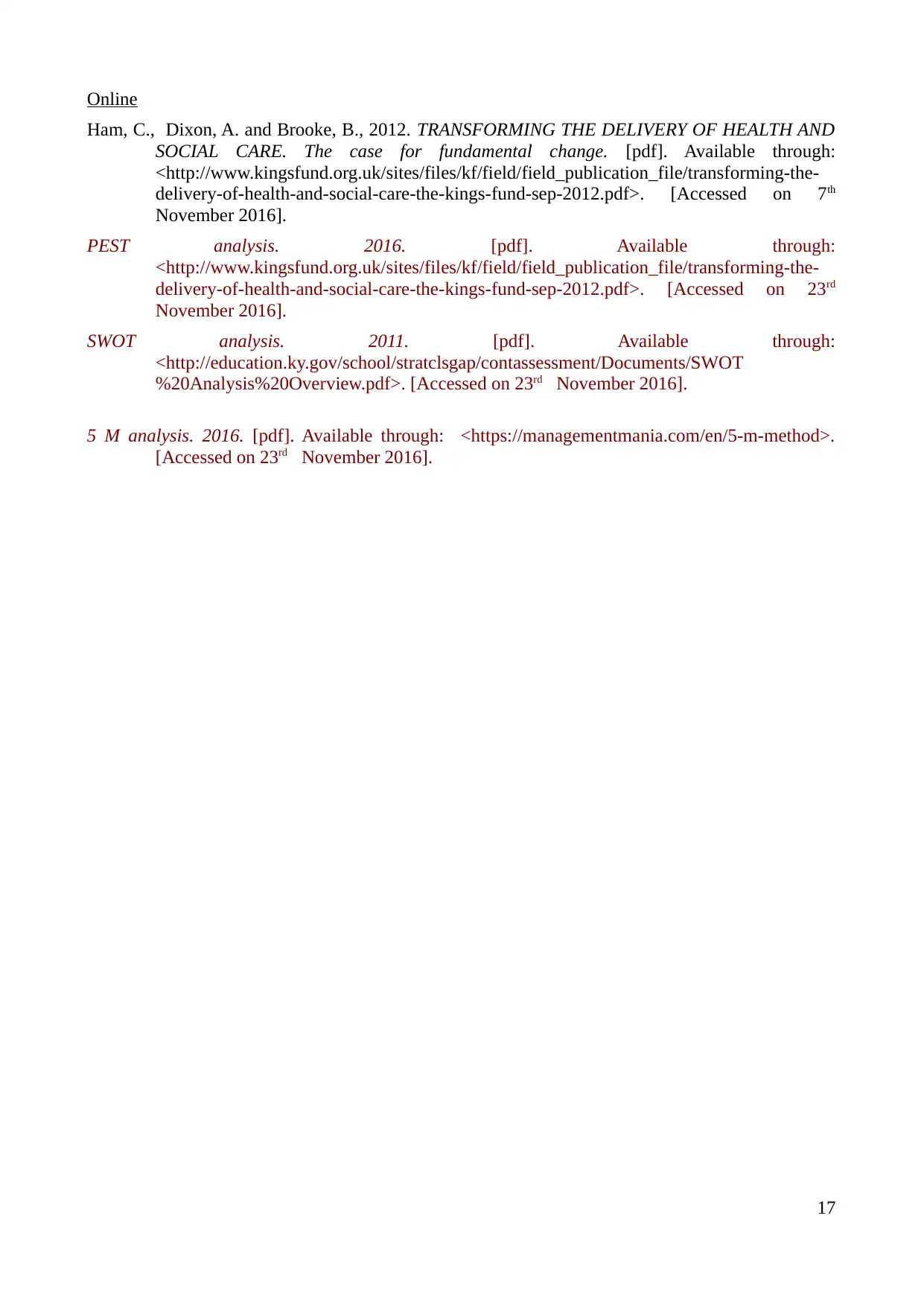
Online
Ham, C., Dixon, A. and Brooke, B., 2012. TRANSFORMING THE DELIVERY OF HEALTH AND
SOCIAL CARE. The case for fundamental change. [pdf]. Available through:
<http://www.kingsfund.org.uk/sites/files/kf/field/field_publication_file/transforming-the-
delivery-of-health-and-social-care-the-kings-fund-sep-2012.pdf>. [Accessed on 7th
November 2016].
PEST analysis. 2016. [pdf]. Available through:
<http://www.kingsfund.org.uk/sites/files/kf/field/field_publication_file/transforming-the-
delivery-of-health-and-social-care-the-kings-fund-sep-2012.pdf>. [Accessed on 23rd
November 2016].
SWOT analysis. 2011. [pdf]. Available through:
<http://education.ky.gov/school/stratclsgap/contassessment/Documents/SWOT
%20Analysis%20Overview.pdf>. [Accessed on 23rd November 2016].
5 M analysis. 2016. [pdf]. Available through: <https://managementmania.com/en/5-m-method>.
[Accessed on 23rd November 2016].
17
Ham, C., Dixon, A. and Brooke, B., 2012. TRANSFORMING THE DELIVERY OF HEALTH AND
SOCIAL CARE. The case for fundamental change. [pdf]. Available through:
<http://www.kingsfund.org.uk/sites/files/kf/field/field_publication_file/transforming-the-
delivery-of-health-and-social-care-the-kings-fund-sep-2012.pdf>. [Accessed on 7th
November 2016].
PEST analysis. 2016. [pdf]. Available through:
<http://www.kingsfund.org.uk/sites/files/kf/field/field_publication_file/transforming-the-
delivery-of-health-and-social-care-the-kings-fund-sep-2012.pdf>. [Accessed on 23rd
November 2016].
SWOT analysis. 2011. [pdf]. Available through:
<http://education.ky.gov/school/stratclsgap/contassessment/Documents/SWOT
%20Analysis%20Overview.pdf>. [Accessed on 23rd November 2016].
5 M analysis. 2016. [pdf]. Available through: <https://managementmania.com/en/5-m-method>.
[Accessed on 23rd November 2016].
17
1 out of 17
Related Documents
Your All-in-One AI-Powered Toolkit for Academic Success.
+13062052269
info@desklib.com
Available 24*7 on WhatsApp / Email
![[object Object]](/_next/static/media/star-bottom.7253800d.svg)
Unlock your academic potential
© 2024 | Zucol Services PVT LTD | All rights reserved.





